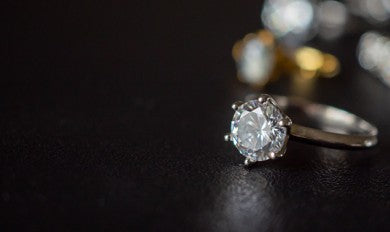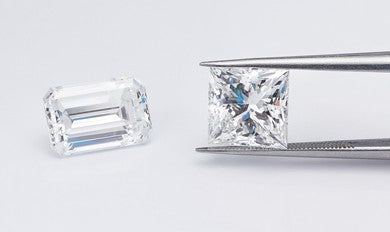
Learn About Diamonds
Diamonds, diamonds, diamonds.
Because we love our profession and because we think it is important to give you as much relevant knowledge about our product(s) as possible, we’re going to share some more in depth info about diamonds with you. Ever heard of the 4 P’s of marketing? Great, but you can forget about those. It’s now time to focus on the 4 C’s of diamonds: cut, color, clarity & carat.
Cut
The diamond cutter is the one who’s ultimately responsible for the diamond’s look. Surprisingly enough, it’s not the shape of a diamond that the cutter is interested in. The cutter has one aim only: the perfectly cut diamond. To do so, he must balance three key elements (proportion, symmetry and polish) to perfection. The better the cut, the more beautiful the diamond. Why? Because its ability to reflect and refract light – a measure of beauty – increases with the quality of the cut.
Color
Diamonds do not just reflect spectral colors, they actually possess, to some extent, coloring – mostly hints of yellow, brown, or gray. The dominant color of a diamond depends on the amount of natural trace elements of nitrogen present while the diamond is going through its forming process. Less color is possible too, although these cases are much more rare. In case color is largely absent, a diamond’s value increases.
Clarity
Clarity refers to how clean, or clear the diamond is with respect to natural microscopic characteristics that were trapped within or on the diamond during its forming process. Such characteristics can either be internal, in which case they’re labeled inclusions, or external. External characteristics, obviously located on the diamond’s surface, are known as blemishes. Inclusions come in a wider variety, but in most cases present themselves in the shape of crystals of a foreign material, or as structural imperfections – small cracks, known as feathers – that usually appear whitish or cloudy and have a negative impact on a diamond’s clarity grade.
Inclusions, as the term suggests, are microscopic diamonds that were absorbed by a larger crystal before the diamond itself made its way to the Earth’s surface. Variables like quantity, size, color, location, orientation, and visibility of inclusions each have some kind of effect on the diamond’s final clarity grade. The smaller the number of inclusions, the higher the value of the diamond.
Carat
Carat (ct.) is a weight measurement specifically used for gems and diamonds. A common misconception of the carat unit is that it is a size measurement, while it is in fact a measurement of weight. Depending on a diamond’s density, the size of two diamond’s with the same carat weight can be considerably different. Carat is a decisive factor in determining a diamond’s price: a higher carat weight will make the price rise exponentially, not linearly. A general rule of thumb is that a diamond with a certain carat weight is four times more expensive than a diamond half its carat weight.
Because we love our profession and because we think it is important to give you as much relevant knowledge about our product(s) as possible, we’re going to share some more in depth info about diamonds with you. Ever heard of the 4 P’s of marketing? Great, but you can forget about those. It’s now time to focus on the 4 C’s of diamonds: cut, color, clarity & carat.
Cut
The diamond cutter is the one who’s ultimately responsible for the diamond’s look. Surprisingly enough, it’s not the shape of a diamond that the cutter is interested in. The cutter has one aim only: the perfectly cut diamond. To do so, he must balance three key elements (proportion, symmetry and polish) to perfection. The better the cut, the more beautiful the diamond. Why? Because its ability to reflect and refract light – a measure of beauty – increases with the quality of the cut.
Color
Diamonds do not just reflect spectral colors, they actually possess, to some extent, coloring – mostly hints of yellow, brown, or gray. The dominant color of a diamond depends on the amount of natural trace elements of nitrogen present while the diamond is going through its forming process. Less color is possible too, although these cases are much more rare. In case color is largely absent, a diamond’s value increases.
Clarity
Clarity refers to how clean, or clear the diamond is with respect to natural microscopic characteristics that were trapped within or on the diamond during its forming process. Such characteristics can either be internal, in which case they’re labeled inclusions, or external. External characteristics, obviously located on the diamond’s surface, are known as blemishes. Inclusions come in a wider variety, but in most cases present themselves in the shape of crystals of a foreign material, or as structural imperfections – small cracks, known as feathers – that usually appear whitish or cloudy and have a negative impact on a diamond’s clarity grade.
Inclusions, as the term suggests, are microscopic diamonds that were absorbed by a larger crystal before the diamond itself made its way to the Earth’s surface. Variables like quantity, size, color, location, orientation, and visibility of inclusions each have some kind of effect on the diamond’s final clarity grade. The smaller the number of inclusions, the higher the value of the diamond.
Carat
Carat (ct.) is a weight measurement specifically used for gems and diamonds. A common misconception of the carat unit is that it is a size measurement, while it is in fact a measurement of weight. Depending on a diamond’s density, the size of two diamond’s with the same carat weight can be considerably different. Carat is a decisive factor in determining a diamond’s price: a higher carat weight will make the price rise exponentially, not linearly. A general rule of thumb is that a diamond with a certain carat weight is four times more expensive than a diamond half its carat weight.





